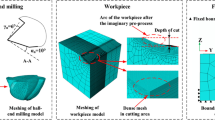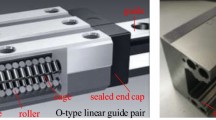Abstract
The parts, in automotive, aerospace, die/mold industry, which have extremely high demands on the quality and integrity of the surface, are usually milled by CNC machine tools. In order to obtain the desirable surface quality, it is an effective way to choose the appropriate cutting parameters before machining by simulating the surface topography formed in the milling process. To do so, this paper develops a model based on the swept surface of the cutting edge and N-buffer model for predicting the surface topography and studies the effect of various cutting parameters. In this developed model, the mathematical equation of the cutting edge is first given, and then based on the relative motion between the cutter and the workpiece, the swept surface of the cutting edge along the tool path is accurately analyzed and modeled from the perspective of kinematics, which is used to describe realistically the cutting interaction between the cutter and the workpiece. Subsequently, the milling process is simulated by an improved N-buffer model by means of the proposed accurate interpolation method for calculating the cusp height. This procedure presents the advantage of not requiring any numerical iteration or approximation to gain the cusp height of any point on workpiece. On basis of the model, the effect of the cutting parameters such as spindle speed, feedrate, inclination angle, path interval, and cutter runout is investigated. Finally, the real machining experiments are performed and compared with the predicted results. The simulated surface topography shows a good agreement with the experimental one. This demonstrates that the developed model can predict accurately the surface topography and also provide the great potential for the surface quality control and the cutting parameter selection in actual production.
Similar content being viewed by others
References
Liu N, Wang SB, Zhang YF, Lu WF (2016) A novel approach to predicet surface roughness based on specific cutting energy consumption when slot milling Al-7075. Int J Mech Sci 118:13–20
Zhang C, Guo S, Zhang HY, Zhou LS (2013) Modeling and predicting for surface topography considering tool wear in milling process. Int J Adv Manuf Technol 68:2849–2860
Raja SB, Baskar N (2012) Application of particle swarm optimization technique for achieving desired milled surface roughness in minimum machining time. Exp Syst App 39(5):5982–5989
Chung YC, Park JW, Shin H, Choi BK (1998) Modeling the surface swept by a generalized cutter for NC verification. Comput Aided Des 30(8):584–587
Feng HS, Li HW (2002) Constant scallop-height tool path generation for three-axis sculptured surface machining. Comput Aided Des 34(9):647–654
Kim BH, Chu CN (1999) Texture prediction of milled surfaces using texture superposition method. Comput Aided Des 31(8):485–494
Ryu SH, Choi DK, Chu CN (2006) Roughness and texture generation on end milled surfaces. Int J Mach Tools Manuf 46(3):404–412
Jung TS, Yang MY, Lee KJ (2005) A new approach to analysing machined surfaces by ball-end milling, part I: formulation of characteristic lines of cut remainder. Int J Adv Manuf Technol 25(9–10):833–840
Jung TS, Yang MY, Lee KJ (2005) A new approach to analysing machined surfaces by ball-end milling, part II: roughness prediction and experimental verification. Int J Adv Manuf Technol 25(9–10):841–849
Liu X, Soshi M, Sahasrabudhe A, Yamazaki K, Mori M (2006) A geometrical simulation system of ball end finish milling process and its application for the prediction of surface micro features. ASME Trans, J Manuf Sci Eng 128(1):74–85
Liu N, Loftus M, Whitten A (2005) Surface finish visualisation in high speed, ball nose milling applications. Int J Mach Tools Manuf 45(10):1152–1161
Antoniadis A, Savakis C, Bilalis N, Balouktsis A (2003) Prediction of surface topomorphy and roughness in ball-end milling. Int J Adv Manuf Technol 21(12):965–971
Buj-Corral I, Vivancos-Calvet J, Domínguez-Fernández A (2012) Surface topography in ball-end milling processes as a function of feed per tooth and radial depth of cut. Int J Mach Tools Manuf 53(1):151–159
Bouzakis KD, Aichouh P, Efstathiou K (2003) Determination of the chip geometry, cutting force and roughness in free form surfaces finishing milling, with ball end tools. Int J Mach Tools Manuf 43(5):499–514
Omar OEEK, El-Wardany T, Ng E, Elbestawi MA (2007) An improved cutting force and surface topography prediction model in end milling. Int J Mach Tools Manuf 47(7):1263–1275
Zhang C, Zhang H, Li Y, Zhou L (2015) Modeling and on-line simulation of surface topography considering tool wear in multi-axis milling process. Int J Adv Manuf Technol 77(1–4):735–749
Arizmendi M, Fernández J, de Lacalle LL, Lamikiz A, Gil A, Sánchez JA, Campa FJ, Veiga F (2008) Model development for the prediction of surface topography generated by ball-end mills taking into account the tool parallel axis offset. Experimental validation. CIRP Annals-Manuf Technol 57(1):101–104
Chen JS, Huang YK, Chen MS (2005) A study of the surface scallop generating mechanism in the ball-end milling process. Int J Mach Tools Manuf 45(9):1077–1084
Zhang WH, Tan G, Wan M, Gao T, Bassir DH (2008) A new algorithm for the numerical simulation of machined surface topography in multiaxis ball-end milling. ASME Trans, J Manuf Sci Eng 130(1):011003
Quinsat Y, Sabourin L, Lartigue C (2008) Surface topography in ball end milling process: description of a 3D surface roughness parameter. J Mater Process Technol 195(1):135–143
Lavernhe S, Quinsat Y, Lartigue C (2010) Model for the prediction of 3D surface topography in 5-axis milling. Int J Adv Manuf Technol 51(9–12):915–924
Quinsat Y, Lavernhe S, Lartigue C (2011) Characterization of 3D surface topography in 5-axis milling. Wear 271(3):590–595
Mizugaki Y, Hao M, Kikkawa K, Nakagawa T (2001) Geometric generating mechanism of machined surface by ball-nosed end milling. CIRP Annals-Manuf Technol 50(1):69–72
Li ZL, Zhu LM (2014) Envelope surface modeling and tool path optimization for five-axis flank milling considering cutter runout. ASME Trans, J Manuf Sci Eng 136:41021
Schneider PJ, Eberly DH (2005) Geometric tool for computer graphics (in Chinese and translated by Zhou CF). Publishing House of Electronics Industry, Beijing
Author information
Authors and Affiliations
Corresponding author
Rights and permissions
About this article
Cite this article
Xu, J., Zhang, H. & Sun, Y. Swept surface-based approach to simulating surface topography in ball-end CNC milling. Int J Adv Manuf Technol 98, 107–118 (2018). https://doi.org/10.1007/s00170-017-0322-1
Received:
Accepted:
Published:
Issue Date:
DOI: https://doi.org/10.1007/s00170-017-0322-1




